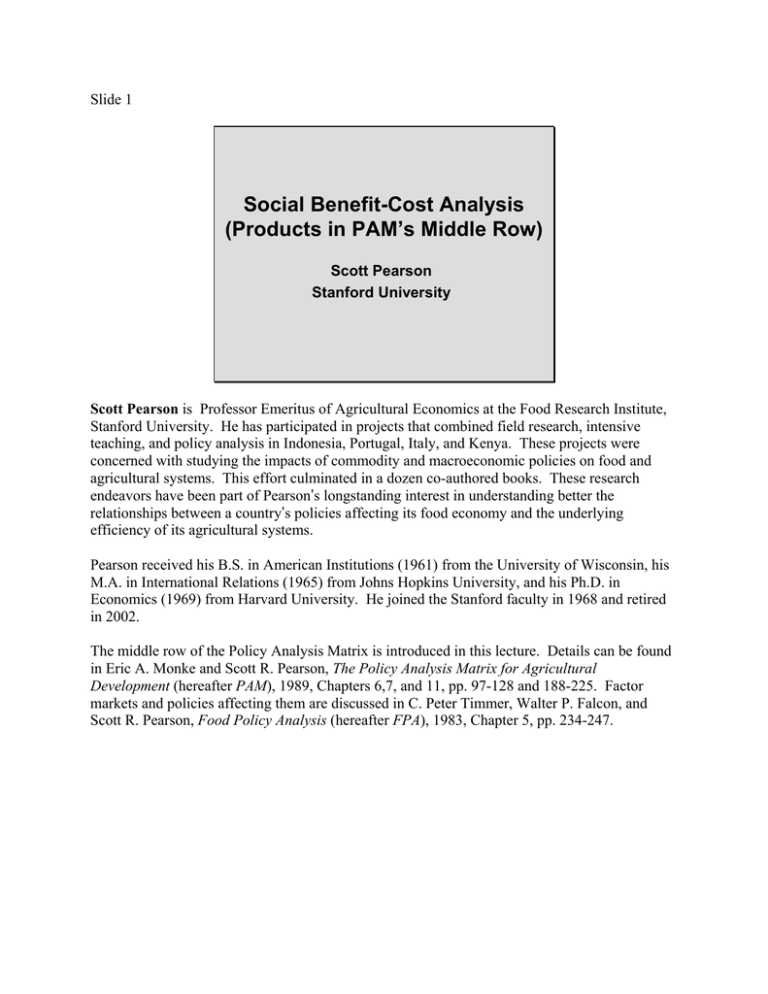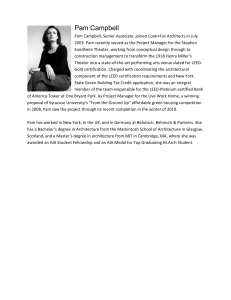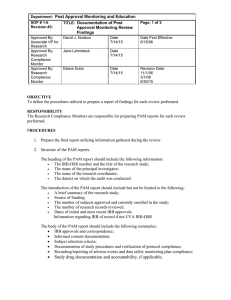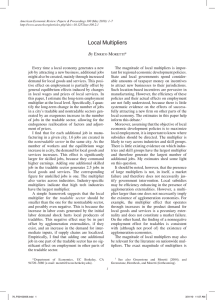Social Benefit-Cost Analysis (Products in PAM`s Middle Row)
advertisement

Slide 1 Social Benefit-Cost Analysis (Products in PAM’s Middle Row) Scott Pearson Stanford University Scott Pearson is Professor Emeritus of Agricultural Economics at the Food Research Institute, Stanford University. He has participated in projects that combined field research, intensive teaching, and policy analysis in Indonesia, Portugal, Italy, and Kenya. These projects were concerned with studying the impacts of commodity and macroeconomic policies on food and agricultural systems. This effort culminated in a dozen co-authored books. These research endeavors have been part of Pearson’s longstanding interest in understanding better the relationships between a country’s policies affecting its food economy and the underlying efficiency of its agricultural systems. Pearson received his B.S. in American Institutions (1961) from the University of Wisconsin, his M.A. in International Relations (1965) from Johns Hopkins University, and his Ph.D. in Economics (1969) from Harvard University. He joined the Stanford faculty in 1968 and retired in 2002. The middle row of the Policy Analysis Matrix is introduced in this lecture. Details can be found in Eric A. Monke and Scott R. Pearson, The Policy Analysis Matrix for Agricultural Development (hereafter PAM), 1989, Chapters 6,7, and 11, pp. 97-128 and 188-225. Factor markets and policies affecting them are discussed in C. Peter Timmer, Walter P. Falcon, and Scott R. Pearson, Food Policy Analysis (hereafter FPA), 1983, Chapter 5, pp. 234-247. Slide 2 Social Profits in the Policy Analysis Matrix • Revenues Input Costs Factor Costs Profits Social (efficiency) Prices • E F G H • social prices – generate highest income • profitability identity – (H = E – (F + G)) • purpose of lecture – identify social prices The second step in the empirical application of the Policy Analysis Matrix (PAM) is an assessment of revenues, costs, and profits in social (efficiency) prices. Data on social revenues and costs are entered in the middle row of the PAM, commonly called the “social row.” The Social row contains measures in social prices (prices that would result in the best allocation of resources and thus the highest generation of income). As mentioned in lecture 2, the symbol E measures revenues in social prices, the symbol F stands for tradable input costs in social prices, the symbol G represents domestic factor costs in social prices, and the symbol H is social profit. Application of the profitability identity (H = E - (F + G)), introduced in Chapter 2, to social revenues and costs gives social profits. Countries achieve rapid economic growth by promoting activities that generate high social profits (large positive H). The purpose of this lecture is to explain how an analyst goes about the practical task of deciding what data to use in the middle (“social”) row of PAM and how to find that information. Slide 3 Social Profits in the Policy Analysis Matrix Revenues Costs Profit Inputs Factors Private Social E F G H Divergences Entries in the middle (Social) row of the PAM are illustrated in this slide. Slide 4 The Social Valuation of Products • social valuations – most challenging analytical task • social opportunity costs – rough approximations • credible social price guesses – key to PAM analysis • basis of calculations of social profit (efficiency) • underpin calculations of divergences (policy transfers and market failures) • central goal – show carefully how social valuations are made Whereas the compilation of budgets for the top row of PAM is the most time-consuming empirical task in PAM analysis, the estimation of social valuations for products and factors of production is the most challenging analytical task in project and policy analysis. Because the information needed for this task is vast and often impossible to find, social valuations can only be approximations. The key to successful PAM analysis is to be able to make reasonable approximations of social prices. If these estimates are good enough to convince policy makers and other economic analysts of their quality and applicability, they will place credence in the calculations of social profitability (efficiency), given by H in PAM, and of divergences (policy transfers and market failures), given by I, J, K, and L in PAM). The central goal is to explain carefully how these social valuations are estimated and to stress that they, by their nature, must be rough approximations. Slide 5 Identifying Social Prices for Tradable Outputs and Inputs • guidelines for social valuation of tradables • same for importables, exportables, outputs, inputs • social prices of tradables – given by border prices • social opportunity cost = import (or export) cost • efficiency – national (not global) concept – distorted world prices thus represent social opportunity costs • Rp world price = $ world price x exch. rate (Rp/$) • l-r efficiency – use l-r $ world price and exch. rate • recent history – use historical $ price and exch. rate Guidelines for the empirical estimation of the prices of tradable goods are identical for importables and exportables and for outputs and inputs. (Social pricing of tradable inputs and outputs is discussed in PAM, pp. 189-196.) The private prices of tradable commodities (for the top row of the Policy Analysis Matrix) are found in the farm budgets from actual market prices at the farmgate, as discussed in lecture 3. The counterpart social prices are border prices (comparable import prices for importables and export prices for exportables). The social (or efficiency) prices of tradable commodities are given by comparable world prices because the import or export price is the best measure of the social opportunity cost of the commodity. For an importable, the import price indicates the opportunity cost of obtaining an additional unit to satisfy domestic demand. For an exportable, the export price is a measure of the opportunity cost of an additional unit of domestic production since that unit would be exported, not consumed domestically. Many international commodity markets are heavily influenced by agricultural price policies, especially those in industrialized economies (the European Union, Japan, and the United States). These world markets thus do not operate efficiently from the point of view of allocating global resources to their best advantage. Agricultural protection and subsidization in rich countries create excess supplies and force world commodity prices downward to levels substantially below what they would be in the absence of policies. But even these distorted international prices provide a useful approximation of the social opportunity cost of importables or exportables in a developing country like Indonesia. If the other countries’ policies are not expected to change in the foreseeable future, the policy-affected world prices still represent the opportunity costs of Indonesian import substitution or export promotion. In this perspective, efficiency for Indonesia is a national concept, not a global one, since Indonesia’s policies only directly affect domestic prices and not international prices for nearly all tradable commodities. The world price in domestic currency units is equal to the world price in foreign currency times the foreign exchange rate (the conversion ratio given in domestic currency units to foreign currency units). Hence, both the world price in foreign currency and the exchange rate are required to calculate the world price in domestic currency. If the analysis is addressing the issue of long-run efficiency (or international comparative advantage), it is appropriate to use long-run trend measures of both the world price (in foreign currency) and the exchange rate. Alternatively, if the study is looking at the historical experience of a recent period (for which the data for the PAM were gathered), it is appropriate to use recent historical data for both world prices (in foreign currency) and the exchange rate. Slide 6 Finding Social Prices for Tradable Outputs and Inputs • finding comparable world prices for tradables • directly – published international trade statistics • trade data – industry groups, donor agencies • indirectly – correcting for (measurable) divergences • comparable world prices – require adjustments • identical location – nearby wholesale market • same time period – main harvest season • comparable form/quality – e.g., 25% broken rice • world price comparisons at farm-gate – if few postfarm divergences – find import (export) parity prices How can PAM analysts find data on comparable world prices for tradable outputs and inputs? The first place to look is in published international trade statistics. If appropriate world prices are not available from the country’s own statistical bureau, they might be found in trade data published by neighboring countries, industry groups, or international organizations (the International Monetary Fund, the World Bank, the Asian Development Bank, or United Nations agencies). In the rare cases when world prices cannot be found directly, it is sometimes possible to estimate them indirectly. If there are no market failures and all policies are known and readily measurable, the researcher can adjust the observed private prices (in entries A and B of PAM) for the effects of divergences (entries I and J) and find the social prices (E and F) as residuals. From the divergences identity, it is known that (A – E = I and B – F = J) and so also (E = A – I and F = B – J). But this procedure can only be done if the effects of divergences, I and J, are measurable, i.e., if there are no quantitative restrictions affecting trade. When finding comparable world prices for tradable outputs and inputs, PAM researchers need to take into account three dimensions – location, time, and quality (or form) – of the commodity. The comparison of a domestic price with a world price must be done at an identical location (e.g., the nearby wholesale market), over the same time period (e.g., the main harvest season), and with a comparable quality of product (e.g., 25 percent broken rice). Otherwise, the prices will not be comparable because of errors introduced by transportation costs (different locations), the costs of or returns to storage (different time periods), and the costs of processing (different qualities or forms of the product). Transformations over location, time, and form are the three roles of agricultural marketing. Comparisons of domestic with world prices of tradables thus need to be done at an identical point in the marketing chain. If divergences are not important in post-farm activities (farm-to-processor transportation, processing, and processor-to-whole-market transportation), it is convenient to collapse the four activities of the PAM into one and thus to carry out the domestic and world price comparisons at the farm-gate level. For this purpose, the researcher needs to find the import parity prices for goods that substitute for imports and the export parity prices for goods that enter export markets. For import parity prices, the costs of domestic transportation and handling are added to the import price at the port, because the imports would have to be moved from the port to the nearby wholesale market to compete with local production. But for export parity prices, the costs of domestic transportation and handling are subtracted from the export price at the port, because the domestic production would have to be moved from the nearby wholesale market to the port before it could be sold abroad. Slide 7 Adjustment of International Prices to Farmgate (I) F.o.b. Thailand ($/ton) 150.00 Freight & insurance ($/ton) 20.00 C.I.f. Indonesia ($/ton) 170.00 Exchange rate (Rp/$) 9,000 Exchange rate premium (%) 0 Equilibrium rate (Rp/$) 9,000 C.I.f. in domestic currency (Rp/ton) 1,530.00 Transport / handling to wholesale (Rp/kg) 133.00 Value before processing (Rp/kg) 1663.00 This slide provides an example of the calculations used to compute the social import parity price of paddy. The calculation of that price begins with the fob (free on board) export price in the exporting country (e.g., $150 per ton of 25 percent broken rice in Bangkok, Thailand). To find the cif (costs, insurance, freight) import price in a domestic port, one adds international freight and insurance costs (e.g., $15 per ton of rice from Bangkok to Jakarta, Indonesia). That cif Jakarta cost in US dollars is then converted into local currency with an appropriate exchange rate (e.g., Rp 9000/US$1). If the calculation hereafter is to be carried out in kilograms rather than tons, that conversion is made. Transportation and handling costs from the port to the nearby wholesale market are added to move the product to that location. Slide 8 Adjustment of International Prices to Farmgate (II) Value before processing (Rp/kg) Processing conversion (%) Cost of rice milling net of bran Import parity value (Rp/kg) Distribution costs to farm (Rp/kg) Import parity value at farm gate(Rp/kg) 1663.00 0.64 50.00 1014.30 50.00 964.30 Because the desired farmgate price is in a different product form, paddy not milled rice, a processing conversion factor is used to convert from milled rice to paddy (e.g., 1 kg paddy = .64 kg milled rice). Corrections also have to be made for milling costs, losses, and moisture content. The last step is to add transportation costs from the processor to the farmgate. Additional procedures and illustrations for calculating import parity and export parity prices are spelled out in the PAM book and computer tutorial that accompany this lecture series. Slide 9 Social Prices for Nontradable Outputs • social valuation of nontradable outputs • no border prices exist for nontradables • correct private prices – for effects of divergences (distorting policies, market failures) – if possible • estimation of social prices for nontradable outputs • correct private prices (A) for identifiable divergences (I) – find social prices (E) as residuals • proxy – seek price of close substitute commodity • proxy – find price of nontradable in neighboring country Different guidelines are proposed for the empirical estimation of the prices of nontradable commodities. As with tradables, the private prices for nontradables are taken from the private budgets at the farmgate level. But no border prices exist to serve as efficiency valuations for nontradables. Hence, the social prices of nontradable outputs are estimated by correcting their private prices for divergences (distorting policies and market failures). Sometimes it is very difficult to estimate the social prices for nontradable commodities. The first step is to correct the private prices of nontradable outputs for identifiable divergences. As noted above for tradable products, the researcher tries to adjust the observed private prices (A) for the effects of divergences (I) and thus find the social prices (E) as residuals. Often, however, the effects of divergences, especially of market failures and sometimes also of distorting policies, are nearly impossible to measure. If the effects of divergences cannot be estimated, the next step is to search for the price of a close substitute commodity to use as a proxy for the social price of the nontradable commodity. If that search fails, the last step is to seek the price of the same commodity (or a close substitute) in a neighboring country. Slide 10 Decomposition of Nontradable Input Costs • nontradable inputs – no comparable world prices • decompose nontradable input costs – into tradable input and domestic factor costs – private and social • disaggregating nontradables – full PAM, very costly – avoid unless input accounts for > 5% total costs • rapid approximations – decomposing nontradables • use national input-output tables – allocate labor, capital shares of nontradables – residual to tradables • use operational rule of thumb – allocate one-third of nontradable costs each to capital, labor, tradables Nontradable input costs cannot be inserted directly into separate columns of a PAM, because there is no direct way of assigning social valuations to this category of costs. There are no comparable world prices for nontradable inputs. The desired solution is to decompose these costs, that is, to disaggregate the cost of producing the nontradable goods or services into their underlying tradable input costs and domestic factor costs (skilled and unskilled labor, capital, and land). Where possible, all nontradable intermediate input costs are allocated among these four PAM categories of costs, and this decomposition is done in both private and social prices. (The decomposition of nontradable input costs is discussed and illustrated in PAM, pp. 145-149, and in the computer tutorial that accompanies this lecture series.) But this decomposition procedure, straightforward in principle, can be extraordinarily timeconsuming in practice. It involves carrying out full PAM analyses of nontradable products and services (e.g., electricity) and thereby diverts the researchers’ attention from agricultural policy. To conserve scarce research resources, separate budgeting exercises to disaggregate nontradable costs should be avoided unless a nontradable input makes up more than 5 percent of total costs of production. Two time-saving approaches can be employed to make rapid approximations in disaggregating nontradable input costs. The first is to use input-output matrices of the national income accounts to allocate labor and capital shares of nontradable inputs in private prices. Land costs are ignored, and the residual is allocated to tradable input costs. The analyst then adjusts the private cost estimates to obtain social approximations. The second, a last resort if no inputoutput table is available, is to employ an operational rule of thumb and allocate one-third of nontradable costs each to the capital, labor, and tradable input cost categories. If the need to make these kinds of arbitrary allocations is widespread, the researcher will need to return to the field for additional information. Slide 11 Tutorial Example of Social Profitability • computer tutorial – high-yielding paddy system • calculates social revenues, costs, and returns • to be completed in parallel with lecture series • three steps – social row in PAM • use earlier table of physical input-output relationships – summarizes technology of production function • compile table of social (efficiency) prices – for all outputs and inputs – key issues in social pricing • find comparable import (export) price – in foreign currency ($) • convert to domestic currency (Rp) – with suitable exchange rate (Rp/$) • adjust domestic currency (Rp) price – to farm-gate level • create social budget – multiply quantities (I-O table) by prices (social prices table) The calculation of social profitability for the illustrative high-yielding rice system in Indonesia is also presented in the accompanying computer tutorial. Like the estimate of private profitability, that for social profits proceeds in three steps. For most PAM applications, the assumption is made that the input-output coefficients are identical for both private and social analyses. Hence, the input-output data reported in lecture 3 in Table 3.1 are repeated in Table 4.2 and are used also in the calculation of social costs and returns. The challenges in social analysis thus arise in finding appropriate social prices for all inputs and products. For tradable inputs and outputs, the key issues are assessing the comparable import or export prices in foreign currency, converting those prices with a suitable exchange rate, and adjusting the domestic currency prices to the farm-gate level. This process of conversion and adjustment for form, time, and location was illustrated above for paddy output in Table 4.1 and Figure 4.2. The full set of social prices for the illustrative paddy system is presented in Table 4.3. As in the creation of a private budget, the final step in creating a social budget is to multiply the quantities in the input-output table (Table 4.2) times the efficiency prices in the social prices table (Table 4.3). The resulting values become the entries in the social budget table (Table 4.4).



